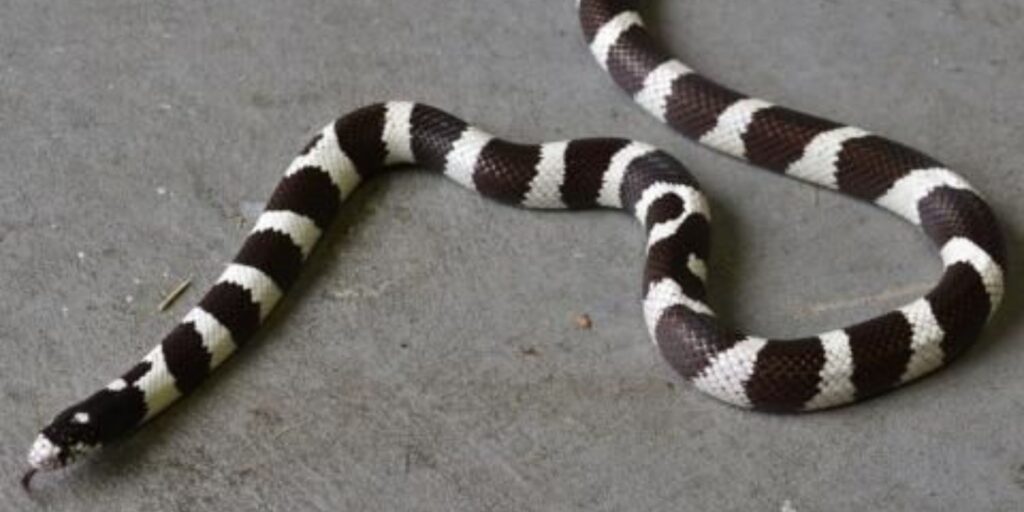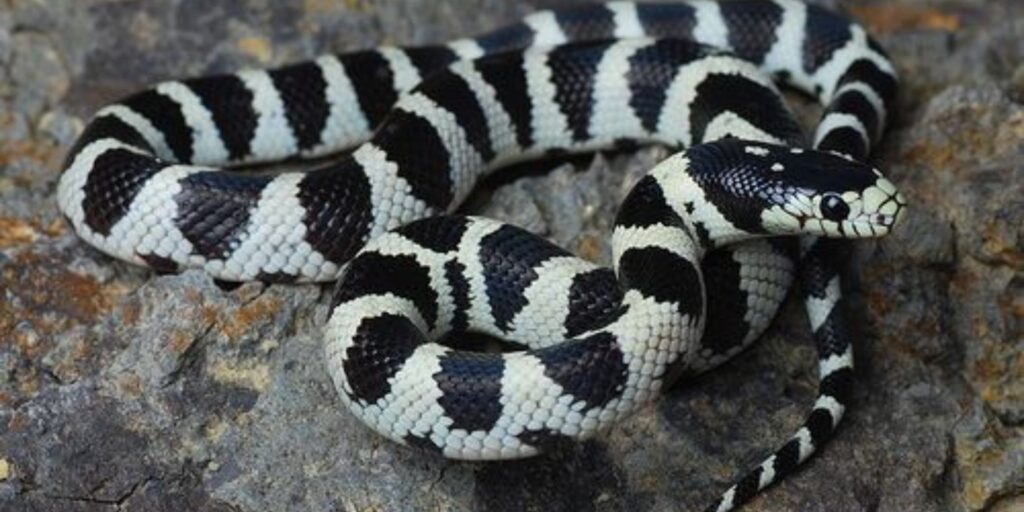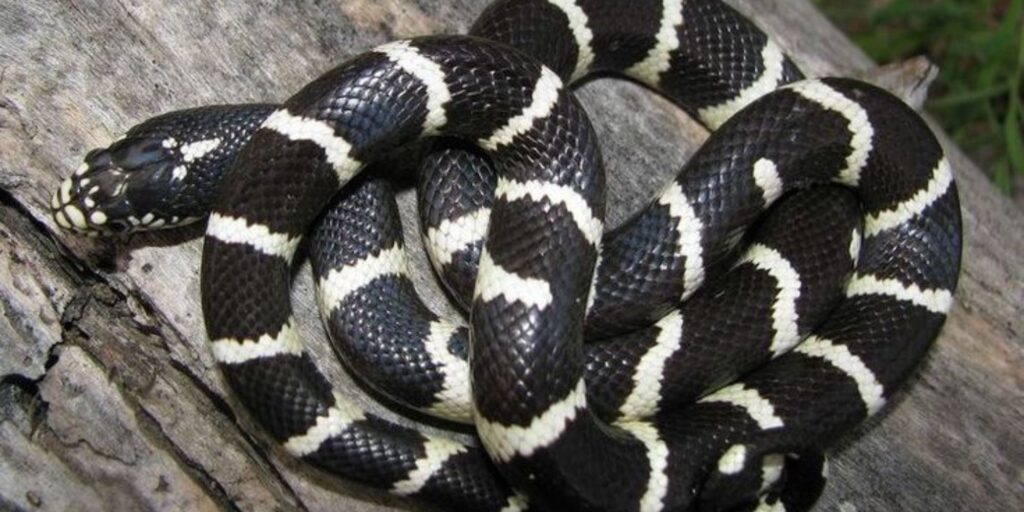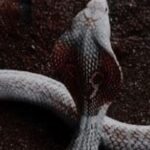Overview
The Black and White Snake stands out due to its striking color contrast. These snakes display bold black and white patterns, which often create a checkerboard effect along their bodies. Various species, such as the California Kingsnake and the Black-and-White Milk Snake, exhibit this eye-catching coloration. The vivid bands help them blend into their environment for camouflage or serve as a warning to predators. Black and white snakes typically live in diverse habitats, from forests to grasslands, depending on the species. While most of these snakes are non-venomous, they rely on constriction to capture and subdue their prey, which often includes small mammals and birds. Known for their calm nature, many black and white snakes make excellent pets, especially for beginner reptile enthusiasts. With proper care, including maintaining the right temperature and diet, these beautiful snakes can thrive in captivity for many years.
Black and White Snake: A Striking Reptile
The black and white snake commands attention with its contrasting colors and bold appearance. These snakes stand out in the world of reptiles due to their eye-catching, striking patterns of black and white scales. In the wild, the black and white coloration serves multiple purposes, including camouflage and defense, while in captivity, these snakes have become highly popular due to their unique and visually appealing appearance. This article delves into the fascinating characteristics, behavior, and care of black and white snakes.
Types of Black and White Snakes

Several species of black and white snakes exist, each with its unique characteristics. The color patterns can vary greatly from one species to another, but the general black-and-white contrast remains a consistent feature. Let’s explore some of the most well-known species.
California Kingsnake
The California Kingsnake (Lampropeltis californiae) is a well-known black-and-white species. Its vibrant black and white or black and cream bands create a beautiful, striking appearance. While some individuals may display different colors, the black-and-white pattern remains the most recognized. These non-venomous snakes have a calm and docile temperament, making them an excellent choice for pet owners. They typically grow between 3 to 4 feet in length, featuring a robust, muscular body. Their adaptability allows them to thrive in diverse habitats, from grasslands to woodlands. As constrictors, California Kingsnakes hunt small mammals, birds, and reptiles, capturing prey with their strength and agility. They are also known to be excellent escape artists, requiring secure enclosures in captivity. These snakes enjoy hiding spaces and climbing structures, reflecting their natural behavior. With proper care, they can live for several years, adding beauty and intrigue to any home or garden.
Black and White Beauty Snake
The Black and White Beauty Snake (Elaphe taeniura), also called the Jungle Carpet Python or Beauty Rat Snake, hails from Southeast Asia. Its striking black-and-white patterns create a sharp contrast that’s mesmerizing to look at. The scales of this species form a beautiful, checkerboard-like appearance, making them highly sought after by reptile enthusiasts. These snakes can grow up to 6 feet in length, boasting elegant, graceful movements. They thrive in tropical forests and are known for their climbing abilities, often resting in tree branches. Despite their exotic appearance, Black and White Beauty Snakes are relatively calm and can tolerate handling. In captivity, they require a humid environment with plenty of space to climb. They are carnivorous, feeding on small mammals, birds, and eggs. Their calm nature and stunning coloration make them popular in the exotic pet trade, though their care requirements can be challenging for beginners.
Black-and-White Milk Snake
The Black-and-White Milk Snake (Lampropeltis triangulum) captivates with its distinct black-and-white patterns. Often mistaken for venomous coral snakes due to their similar coloration, these snakes are harmless. They feature alternating black-and-white or cream-colored bands along their bodies, creating a bold contrast. Typically, Black-and-White Milk Snakes reach 2 to 3 feet in length. These snakes thrive in various habitats, such as forests, grasslands, and rocky areas. They can mimic the appearance of more dangerous species, which helps them avoid potential predators. Milk snakes hunt small animals like rodents and lizards, using their constriction skills. Their striking appearance and low-maintenance nature make them popular in pet collections. Black-and-White Milk Snakes are non-aggressive and thrive in captivity when given proper care and attention. These snakes offer an appealing combination of beauty, adaptability, and ease of care for enthusiasts and collectors.
Zebra Snake
The Zebra Snake is a smaller species with distinct black and white bands that resemble a zebra’s stripes. This striking appearance provides both beauty and camouflage, as the alternating colors help the snake blend into its environment. Zebra Snakes are non-venomous, and they rely on their camouflage to avoid predators rather than venomous defense mechanisms. These snakes are often found in rocky or sandy areas, where their coloring helps them remain inconspicuous. Despite their smaller size, Zebra Snakes exhibit remarkable agility and speed, making them efficient hunters. They primarily feed on small insects, lizards, and rodents. Although less common than other black and white species, Zebra Snakes are gaining popularity among reptile enthusiasts for their unique pattern and low-maintenance care. Their relatively small size and non-aggressive nature make them an ideal choice for first-time snake owners, offering both charm and simplicity.
White and Black Garter Snake
The White and Black Garter Snake (Thamnophis sirtalis) is a variant of the common garter snake that displays black and white stripes along its body. Unlike most garter snakes that are greenish or brown, these snakes feature distinct black-and-white or yellow markings running along their backs. They are commonly found in North America, particularly in gardens, grassy fields, and wetlands. These non-venomous snakes use their agility to catch small prey, such as insects, amphibians, and rodents. Their black-and-white coloration helps them blend into their environment, providing effective camouflage. Garter snakes are active creatures, often seen rapidly slithering through tall grass or underbrush. They have a mild temperament, making them easy to handle. While they prefer moist environments, garter snakes can adapt to various settings. Their harmless nature and striking appearance make them popular with wildlife enthusiasts and pet owners alike.
Physical Appearance of Black and White Snakes
Black and white snakes can vary in their appearance, depending on the species, but several characteristics remain consistent across many species:
Color and Patterns
The most striking feature of black and white snakes is their color contrast. The black scales of the snake may range from a deep, rich black to a slightly brownish black. In contrast, the white or cream-colored scales appear bright and often create a sharp contrast against the darker hues. Some species may exhibit striped patterns, while others may have blotches or checkered markings.
Size and Shape
Black and white snakes vary in size. Some species, like the California Kingsnake, can grow to over 4 feet, while others, like the Zebra Snake, are much smaller. In general, these snakes have elongated bodies with narrow heads, and their muscular builds enable them to constrict and subdue prey effectively.
Skin Texture
Many black and white snakes have smooth or slightly keeled scales. The texture of the skin may vary, but it plays a role in the snake’s ability to move quickly through different terrains. Snakes with smooth skin are generally more agile, while those with keeled scales tend to have more grip on surfaces, aiding in climbing or burrowing.
Eyes and Head
Black and white snakes have dark pupils in their eyes, making them stand out from their scales. These eyes help the snakes hunt in different lighting conditions, as many black and white snakes are crepuscular or nocturnal. Their heads tend to be slightly narrower than their bodies, which is common in constrictor species. This head shape allows them to move through tight spaces and efficiently subdue prey. The eye structure also aids in detecting movement, ensuring they can track potential meals or avoid predators.
Habitat and Distribution

Black and white snakes are distributed across various regions, from North America to Southeast Asia. While some species prefer temperate environments, others thrive in tropical climates. The habitat preferences of black and white snakes vary based on the species, but most of them favor areas with ample cover and a steady supply of prey.
California Kingsnake Habitat
The California Kingsnake thrives in diverse environments across North America. It is commonly found in grasslands, woodlands, and even urban areas. This adaptability allows the California Kingsnake to survive in a wide range of habitats. It typically favors areas with abundant shelter, including rocks, logs, and abandoned burrows. These hiding spots protect from predators and harsh weather conditions. California Kingsnakes are often seen near water sources, though they are not aquatic. They enjoy areas with dense vegetation, which offers both cover and food sources like rodents, birds, and reptiles. While they are terrestrial by nature, California Kingsnakes are skilled climbers, sometimes found in trees or shrubs. Their ability to live in various environments has made them a successful species across different regions. With their varied habitat preferences, these snakes continue to thrive in both natural and urbanized landscapes.
Black and White Beauty Snake Habitat
The Black and White Beauty Snake (Elaphe taeniura) inhabits forested and rocky regions of Southeast Asia. This species favors areas with dense vegetation, providing ample cover and climbing opportunities. Black and White Beauty Snakes are primarily arboreal, spending most of their time in trees or shrubs. These snakes seek environments that offer both shelter and food, such as small mammals, birds, and eggs. Their preference for climbing helps them find prey while avoiding ground predators. They are often found in tropical forests, where humidity levels are high and temperatures remain warm. Dense foliage and branches allow the Black and White Beauty Snake to move with ease. The snake’s habitat needs also include spaces with rocky outcrops or hollow trees for resting. While they can survive in a variety of environments, these snakes thrive most in their natural, densely vegetated habitats.
Zebra Snake Habitat
The Zebra Snake thrives in a wide range of habitats across North America, from grasslands to forests. These snakes are incredibly adaptable, managing to survive in both humid and dry climates. However, they tend to prefer environments with slight humidity, often near water sources. Zebra Snakes are commonly found in areas with plenty of ground cover, such as tall grasses or underbrush, where they can remain hidden from predators. Their zebra-like coloration helps them blend into their surroundings, providing effective camouflage. These snakes are often seen in suburban areas, where they make use of gardens or yards that offer suitable shelter and food sources. While they are highly adaptable to various climates, Zebra Snakes generally avoid extreme environments. Their habitat choice ensures access to a steady supply of prey, such as small rodents, insects, and amphibians, which form the bulk of their diet.
Behavior and Temperament
Black and white snakes are generally calm and non-aggressive, though their temperament can vary by species. Most black and white snakes rely on their camouflage to avoid detection rather than aggressive defense mechanisms. These snakes tend to be secretive, seeking shelter in rocks, logs, or foliage. They usually avoid confrontation with predators, using their ability to blend into their surroundings as their primary defense. However, some species will defend themselves by hissing or striking when threatened. Despite their calm nature, certain species may exhibit defensive behavior when cornered. For instance, California Kingsnakes can become more assertive if they feel threatened, but they are not typically aggressive toward humans. Black and White Beauty Snakes, on the other hand, remain relatively docile and tolerate handling well. Their overall temperament makes them suitable as pets and easy to care for in captivity.
Activity and Hunting
Many black and white snakes are nocturnal or crepuscular, meaning they are most active during twilight hours or at night. These snakes rely on their keen sense of smell and heat detection abilities to hunt for prey. They often seek small mammals, birds, and insects, using their constriction technique to subdue the prey. Once they locate their prey, black and white snakes will strike quickly and wrap their bodies around it, squeezing until the animal is immobilized. They use their muscular bodies to suffocate their prey, ensuring a secure meal. Their hunting strategy does not involve venom; instead, they depend on their strength and stealth. The snake’s activity level varies with the species. For example, some species, like the California Kingsnake, are more active during the day, while others prefer night hunting. Their ability to adapt their hunting patterns ensures their survival in various environments.
Defense Mechanisms
While many black and white snakes are non-venomous, they have developed effective defense mechanisms to protect themselves from predators. When threatened, some species may coil tightly and hiss loudly, trying to intimidate potential threats. This defensive posture serves as a warning to predators to stay away. Other species, like the Black and White Beauty Snake, may mimic the appearance and behavior of more dangerous snakes, deterring predators by resembling venomous species. The Zebra Snake’s bold black-and-white pattern also acts as camouflage, allowing it to blend into its environment and avoid detection. In extreme cases, some black and white snakes may strike if they feel cornered, though they do so primarily as a last resort. These defense mechanisms are designed to prevent conflict and allow the snake to escape unharmed, using non-aggressive methods to ensure their safety.
Reproduction and Lifespan
Black and white snakes typically reproduce by laying eggs, with most species mating in spring or early summer. During mating season, males often compete for the attention of females, and once a female is fertilized, she lays a clutch of eggs. These eggs incubate for several weeks before hatching, typically in late summer or early fall. The eggs provide a safe environment for the developing embryos, protecting them from predators. Once hatched, baby snakes are fully independent and must fend for themselves. The lifespan of black and white snakes varies by species but generally ranges from 10 to 20 years in captivity. In the wild, their lifespan may be shorter due to natural threats and environmental challenges. With proper care, these snakes can live long, healthy lives in captivity. Their reproductive habits and lifespan make them an enduring species in both wild and domestic settings.
Care of Black and White Snakes in Captivity
Black and white snakes make for interesting and low-maintenance pets, provided their needs are met. The following guide will help ensure that your black and white snake remains healthy and happy.
Enclosure and Environment
Provide your snake with a spacious enclosure that mimics its natural environment. Snakes such as the California Kingsnake or Zebra Snake need a habitat with plenty of hiding spots, such as rocks, branches, or logs. Ensure that the enclosure is well-ventilated and has a temperature gradient, with warmer and cooler zones.
Temperature and Humidity
Black and white snakes generally prefer a warm environment, with a temperature range of 75°F to 85°F. However, they also need access to cooler areas in their enclosures. Maintain a humidity level that suits the species, as some snakes, like the Black and White Beauty Snake, require higher humidity than others.
Diet
In the wild, black and white snakes feed on rodents, birds, and reptiles. In captivity, they typically eat frozen-thawed rodents, which should be offered every 5 to 7 days for adult snakes. Baby snakes may require smaller meals more frequently. Always ensure that the food is appropriately sized for the snake to avoid choking.
Handling
Black and white snakes, especially species like the California Kingsnake and Black and White Beauty Snake, are generally calm and tolerate handling well. However, it’s essential to handle them gently and avoid excessive stress. Regular handling will help the snake become accustomed to human interaction but always handle with care to prevent injury.
Conclusion

The black and white snake is a captivating and diverse group, with each species displaying unique patterns and characteristics. From the California Kingsnake to the Zebra Snake, these snakes offer a stunning combination of bold contrast and elegance. Whether they thrive in forests, grasslands, or even suburban areas, their ability to adapt to various habitats showcases their resilience. These snakes often rely on camouflage for protection, using their striking colors to blend into their environment. Many are non-venomous and prefer to use agility and constriction to hunt prey, contributing to their charm and appeal. As pets, they are known for their docile nature, making them an ideal choice for reptile enthusiasts. Understanding their specific needs and providing proper care ensures these snakes thrive both in the wild and in captivity. The black and white snake continues to fascinate, offering both beauty and intrigue to those who encounter them.



